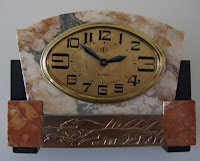 |
| 1870? |
In 1867, Albert Villon established his clockmaking shop in Saint Nicholas and began creating small 'domestic' alarm and mantle clocks, utilizing Japy Frères' famous enamel dials. Villon identified his clocks by includiing his initials A.V. on the back and added his logo, the "lion passant" or walking lion which became the trademark for over eighty years..
In 1896, Albert Villon associated himself with Paul Duverdrey and Joseph Bloquel and the three of them created the company known as Albert Villon, Duverdrey et Bloquel which operated under that name until Villon's death in 1902.
It was then rebaptized Duverdrey & Bloquel and in 1928, the brand name Bayard was retained. Bayard was chosen in reference to a character of French history known as the Chevalier de Bayard, who was without fear and without reproach.
From 1928 to about 1932, many of the clocks produced were stamped with both names - Duverdrey & Bloquel - Bayard mostly on the clock mechanism and finally only Bayard was kept along with the logo of the walking lion. Interestingly, people still confuse the Bayard lion with the car manufacturer Peugeot's lion even though the two of them are dramatically different in design.
 |
| Logo stamped on Bayard mechanisms |
With the increasing mechanization of the manufacturing process, Bayard clocks were mass produced and exported to the four corners of the world during the 1930's - a feat in itself. They also produced models for private brands such as Tribaudeau and the Manufrance catalogue. Many of the clocks produced by Duverdrey & Bloquel did not have identification marks on the case, only on the clock's internal mechanism which makes identification sometimes a bit tricky. This is especially true for clocks that were manufactured for export.
 |
| 1926 - 29 Bayard stamp on mechanism |
 |
| 1931 Solid brass clock case |
 |
| 1932 Blue leather desk clock case |
The most easily recognizable Bayard clock is the one with the enamel dial and Roman numerals that was produced in varying sizes and case finishes.
 |
| 1931 'bijou' type models |
 |
| 1934 Large mantle clock style in marble case stamped 'TRIB'. |
 The model on the left is one of Bayard's best- known and most popular. Produced around 1937, its chrome case and stylized numbering made it into a best-seller. It was also sold in brass, porcelain and stamped Bayard & Bayard . It was a completely new model of clock for the manufacturer.
The model on the left is one of Bayard's best- known and most popular. Produced around 1937, its chrome case and stylized numbering made it into a best-seller. It was also sold in brass, porcelain and stamped Bayard & Bayard . It was a completely new model of clock for the manufacturer.
On a personal note, Bayard's clock mechanisms are surprisingly sturdy.






















